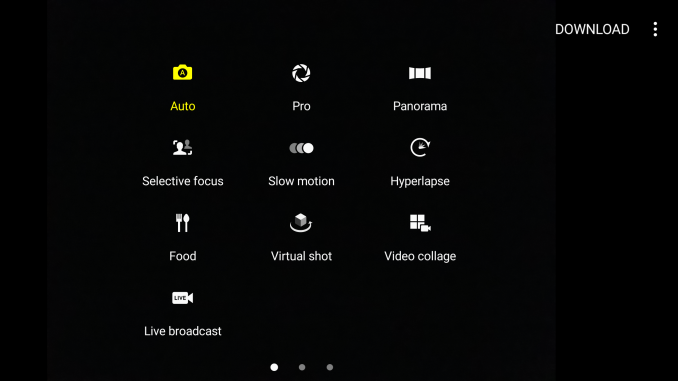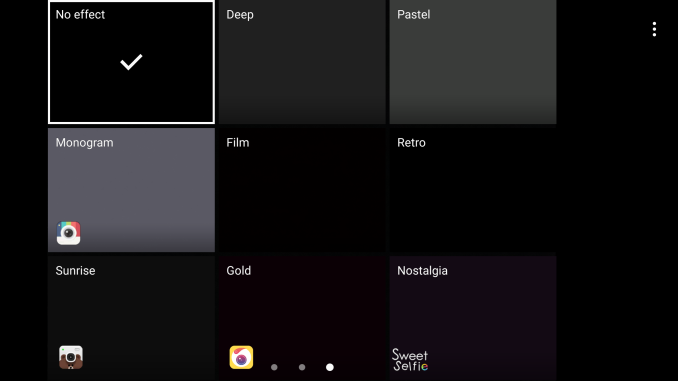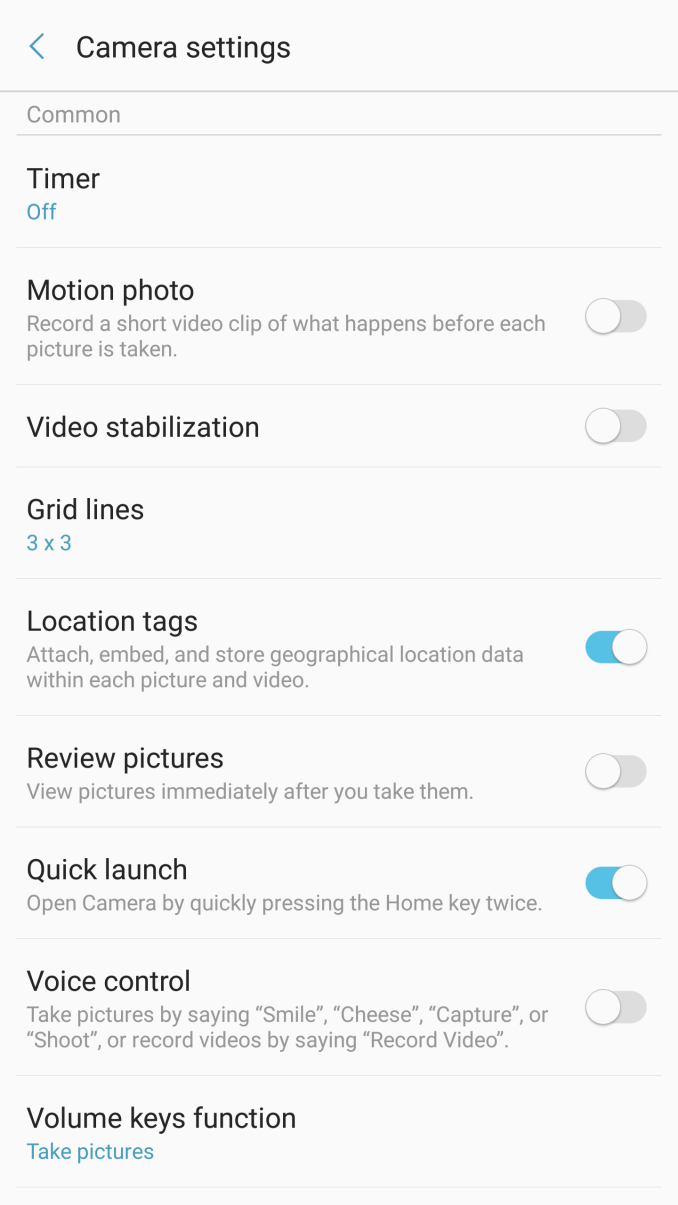The Samsung Galaxy Note7 (S820) Review
by Joshua Ho on August 16, 2016 9:00 AM ESTCamera Architecture
In general, camera has become probably the single biggest point of differentiation between smartphones at this point. As smartphones are often the only camera that most people carry on a day to day basis, the rear camera on a smartphone really cannot be a disappointment relative to the competition. While we can talk about how much a front-facing camera matters in terms of quality, it’s pretty safe to say that for photos and videos that are worth saving will be taken with the rear-facing camera.
While post-processing and a number of other factors are going to have a huge impact on the overall camera experience, the foundation that makes it possible to deliver a great camera is always going to start at the hardware.
| Samsung Galaxy Note Cameras | ||||
| Galaxy S6 Galaxy Note5 |
Galaxy S7 Galaxy Note7 |
|||
| Front Camera | 5.0MP | 5.0MP | ||
| Front Camera - Sensor | Samsung S5K4E6 (1.34 µm, 1/4") |
Samsung S5K4E6 (1.34 µm, 1/4") |
||
| Front Camera - Focal Length | 2.2mm (22mm eff) | 2.1mm (21mm eff) | ||
| Front Camera - Max Aperture | F/1.9 | F/1.7 | ||
| Rear Camera | 16MP | 12MP | ||
| Rear Camera - Sensor | Sony IMX240 Samsung S5K2P2 (1.12 µm, 1/2.6") |
Sony IMX260 Samsung S5K2L1 (1.4 µm, 1/2.6") |
||
| Rear Camera - Focal Length | 4.3mm (28mm eff) | 4.2mm (26mm eff) | ||
| Rear Camera - Max Aperture | F/1.9 | F/1.7 | ||
It’s probably not any surprise that the Galaxy Note7 has the same exact camera setup as the Galaxy S7, but in case it was ever in doubt it shouldn’t be now. Given the similar camera setup I don’t think that there’s a ton of difference to be expected between the two phones but things like software algorithms can and do change with time so it’s important to not just immediately write off the Galaxy Note7 or assume it’s immediately going to be award-winning. It’s worth reiterating here that the dual pixel system likely incurs a sensitivity penalty as in order to implement the dual pixel system each pixel must have a physical light barrier as you need a microlens and a barrier to make light from the same object converge on two separate photodiodes so the amount of light collected is inherently going to be less than no barrier and a single photodiode per pixel. I’m also curious to know whether any quantum effects appreciably change sensitivity here as if a single pixel is a 1.4 micron square then each photodiode has area similar to a 1-micron pixel. With that said we can move on to the one major change highlighted by Samsung, namely the user experience.
Camera UX
One of the major points highlighted in the launch event was that the camera application was completely redesigned. In addition to a fairly subdued icon that better fits the color palette for Android in general, the UI itself is a bit cleaner out of the box.
Right away when you open the camera app the most apparent thing is that the number of icons has been reduced. Instead of a dedicated mode button it’s now a swipe, and the same is true of the effects button. There’s also no more timer or resolution button on the screen by default, and the button to hide the various settings buttons has been eliminated entirely. It’s also worth mentioning that the button to change between cameras has been moved and a gesture to do the same thing has been added so you can simply swipe up or down to switch between cameras. Samsung also continues to shut off the camera after a few minutes automatically which is good if you’re a normal user but annoying if you’re trying to set up a shot of an ISO chart with a tripod.
Other than these changes almost nothing else really changes. There are some extra toggles like shape correction in the settings overflow and RAW output is now hidden under Picture Size for the rear camera but nothing else is really notable. I don’t really have anything else to say here that’s new, and I would refer to the Galaxy S7 Part 2 review if you are otherwise unfamiliar with Samsung’s camera application. As both perform identically as far as focus and capture speed goes subjectively we’ll temporarily forgo these results in favor of timeliness for this review.















202 Comments
View All Comments
CloudWiz - Thursday, August 25, 2016 - link
Yes, I know it has a Qualcomm modem. I also understand that the S820 versions of the GS7 have comparable Wifi/LTE results because of Qualcomm's modem prowess. However, this has nothing to do with the SoC. The Samsung S820 implementation is still far more inefficient than the Exynos implementation or other OEMs' implementations.The GS6 had a Samsung Shannon modem that was notoriously inefficient on LTE. That is a fact. And your comment forgets that the Note 7 also has a 30% larger battery, and in no way does 50% extra PenTile pixels translate to 50% increased battery drain.
CloudWiz - Thursday, August 25, 2016 - link
Addendum: The Note 7 also comes with an updated modem, further helping reduce battery drain. Coupled with the fact that the S820 is more tightly integrated than A9 with respect to the modem, it really isn't that surprising that the Note 7 is able to last a bit longer.StevoLincolnite - Tuesday, August 16, 2016 - link
Having Glass on the back AND front of the Phone is just asking for trouble... Wish Samsung would employ more durable materials.It wasn't a great material choice when Apple did the same years ago... It's still not a great material choice in 2016 either.
I had a Note 5 for a whole 2 days, slipped off the desk once and that was the end of that, the Note 7 is just more of the same.
My old Nokia Lumia took more abuse than that and I had it for almost 4 years, without a cover. Heck, I even purposely dropped it a few times and it just bounced without any damage.
jayfang - Tuesday, August 16, 2016 - link
Agreed. Does not matter how nice something looks when you have to put it in cover for grip and protection.lilmoe - Tuesday, August 16, 2016 - link
Brah.... As painful as it is, let it go. We never wanted crappy glass backs, but the world has voted with their wallets. They don't want "durable" materials, they want design and features.That being said, glass is still better than metal since it allows better radio and wireless charging. Until you design an alloy or mag-field that can support that, glass is here to stay.
I want my plastic backs back....................................
StevoLincolnite - Wednesday, August 17, 2016 - link
Voted with their wallets? Not really.If a company deserves criticism for various aspects related to their products, then I implore people to criticize, otherwise companies become complacent.
I personally prefer the rubbery polymer materials that some Phones use, it's matte so it doesn't attract fingerprints, it has a good texture that assists with grip and doesn't reduce signal reception and it allows for wireless charging (A feature I have loved for years now with my old Lumia).
Samsung can shove their Glass where the sun doesn't shine, I won't be buying another Samsung device until they change their materials.
lilmoe - Wednesday, August 17, 2016 - link
And how many of you are there? How many of us are there? When samsung made what we liked their sales tanked. Don't blame Samsung, blame the online community.StevoLincolnite - Wednesday, August 17, 2016 - link
Samsung kinda' ignored what the people wanted with the Note 5.* Glass back.
* No MicroSD.
* No replaceable battery.
And then sales tanked.
jospoortvliet - Thursday, August 18, 2016 - link
They nailed it with the S7... including the glass back... and yes I also would have preferred metal.TheinsanegamerN - Wednesday, August 17, 2016 - link
We should crowdsource our own phone, with a plastic back, removable battery, ece. Make a truly durable piece of equipment.